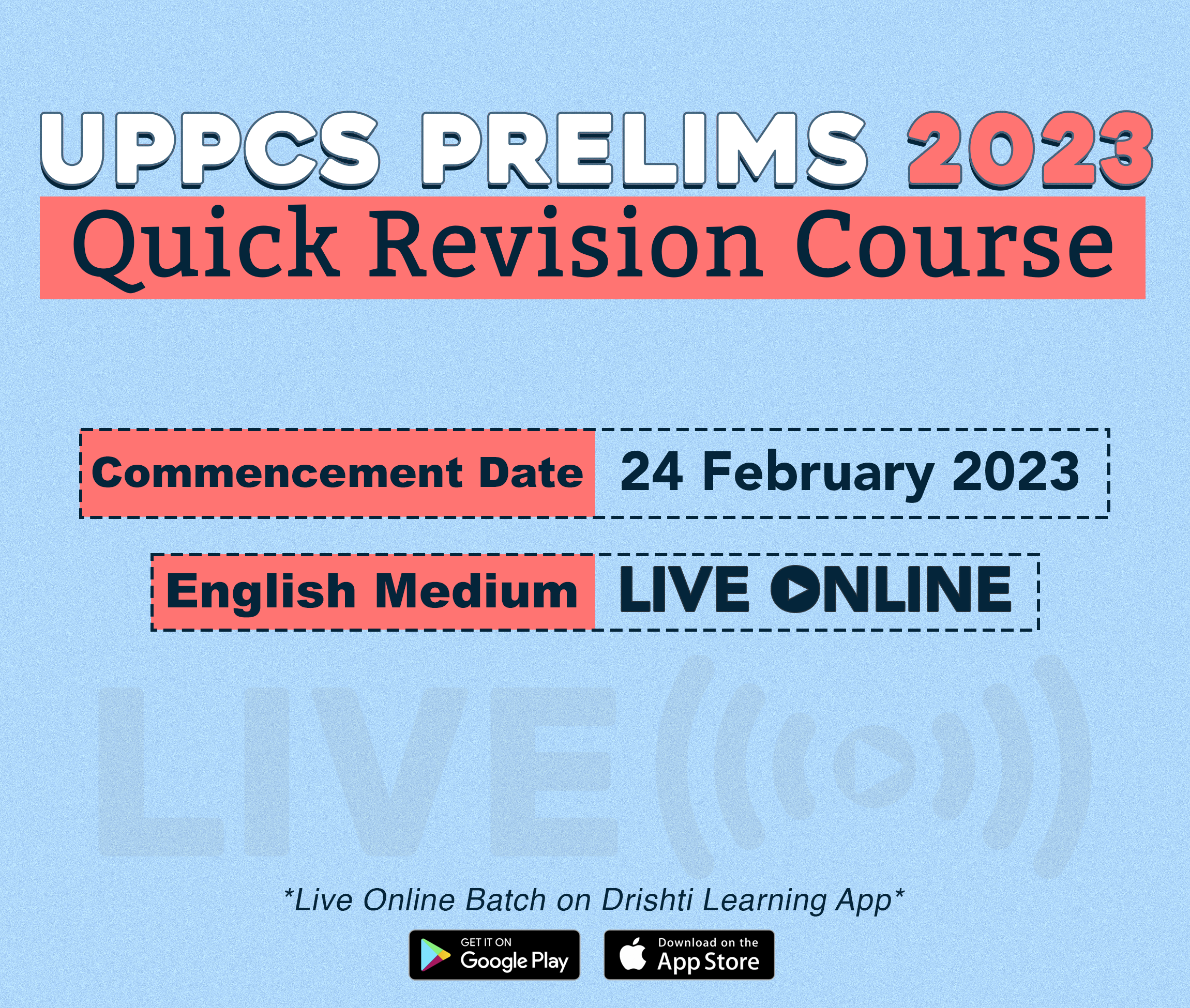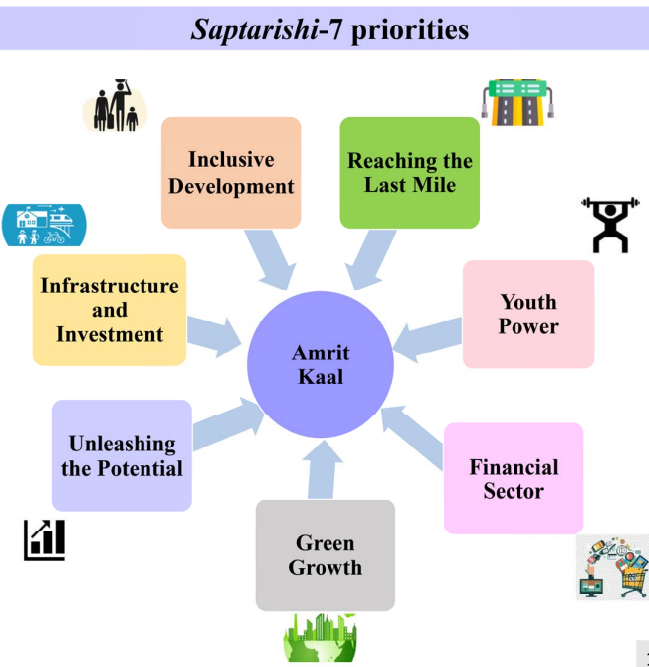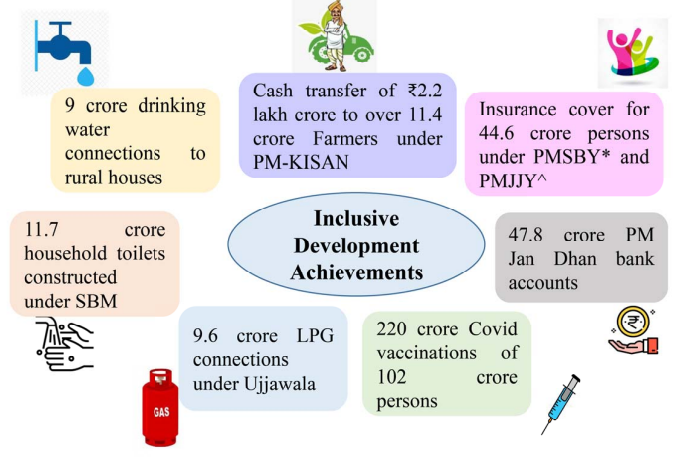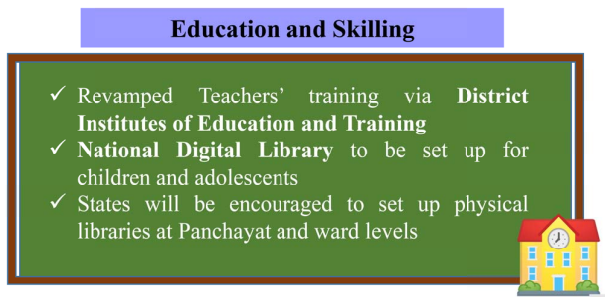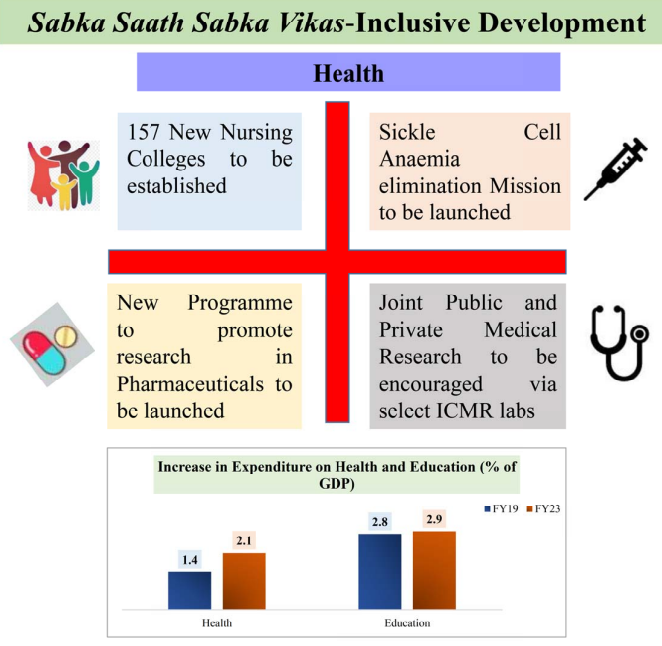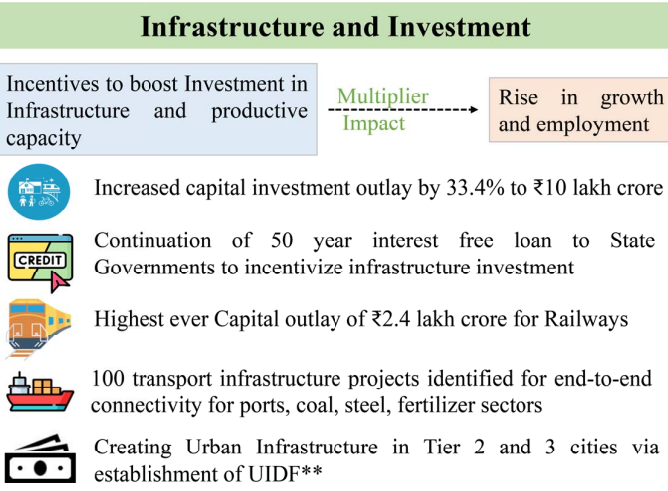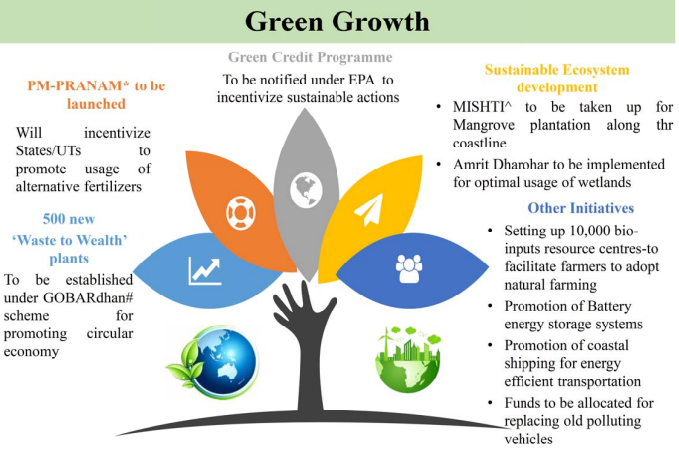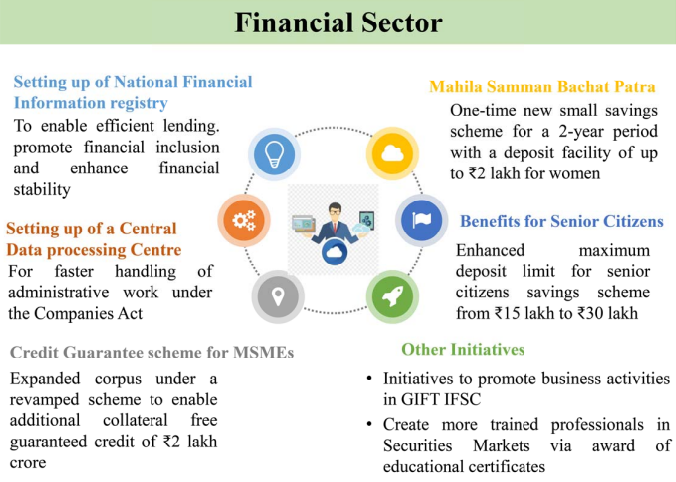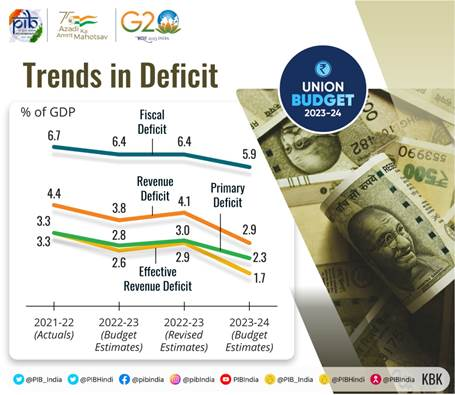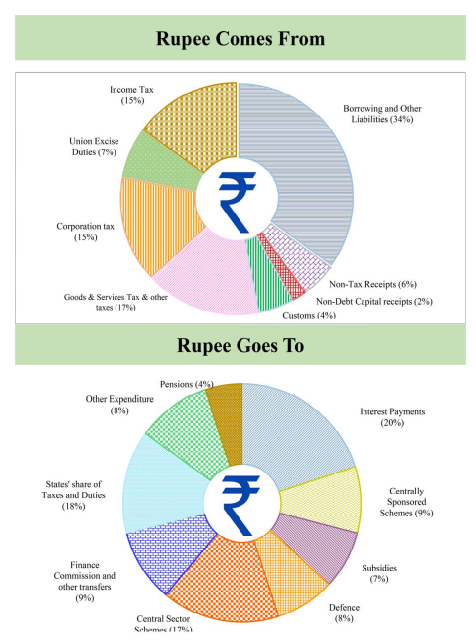Governance
Union Budget 2023-24
Why in News?
The Finance Minister of India introduced the last full-fledged Union Budget (for 2023-24) before the Lok Sabha elections of 2024.
What are the Constitutional Provisions regarding Budget?
- According to Article 112 of the Indian Constitution, the Union Budget of a year is referred to as the Annual Financial Statement (AFS).
- It is a statement of the estimated receipts and expenditure of the Government in a Financial Year (which begins on 1st April of the current year and ends on 31st March of the following year).
- Overall, the Budget contains:
- Estimates of revenue and capital receipts,
- Ways and means to raise the revenue,
- Estimates of expenditure,
- Details of the actual receipts and expenditure of the closing financial year and the reasons for any deficit/surplus in that year, and
- The economic and financial policy of the coming year, i.e., taxation proposals, prospects of revenue, spending programme and introduction of new schemes/projects.
- In Parliament, the Budget goes through six stages:
- Presentation of Budget
- General discussion
- Scrutiny by Departmental Committees
- Voting on Demands for Grants
- Passing an Appropriation Bill
- Passing of Finance Bill
- The Budget Division of the Department of Economic Affairs in the Ministry of Finance is the nodal body responsible for preparing the Budget.
- The first Budget of Independent India was presented in 1947.
What are the Highlights of Budget 2023-24?
- A key theme of Union Budget 2023-24 is the focus on inclusive development - Sabka Sath, Sabka Vikas which specifically covers;
- Farmers, Women, Youth, Scheduled Castes, Scheduled Tribes, Other Backward Classes (OBCs), Divyangjan (PwDs) and Economically Weaker Sections (EWS),
- Overall priority for the underprivileged (vanchiton ko variyata),
- There has also been a sustained focus on UTs of J&K and Ladakh and the Northeast Region (NER).
- The Budget is along the lines of the two-pronged growth strategy first unveiled in 2019:
- Incentivising the private sector thus creating jobs and pushing growth.
- ‘Minimum Government, Maximum Governance’; increasing capex and raising more revenues via disinvestment.
- Key Takeaways of the Budget:
- Changes in the new income tax regime (in rebate limit and in tax slabs).
- A 33% increase in capital investment outlay has been proposed, raising it to Rs 10 lakh crore (the biggest in the past decade).
- Changes in customs duty; reduced on import of certain inputs for mobile phone manufacturing, shrimp feed etc. and increased on cigarettes, gold articles, compounded rubber etc.
- Capital outlay for the railways increased to the highest ever – Rs 2.40 lakh crore.
Part – A
What is the Budget’s Vision for Amrit Kaal?
- Amrit Kaal:
- The Finance Minister of India called it the first Budget in Amrit Kaal. The vision for the Amrit Kaal is an empowered and inclusive economy that is technology-driven and knowledge-based with a robust financial sector.
- The Budget identifies 4 transformative opportunities to be leveraged before reaching India@100:
- Economic Empowerment of Women through SHGs
- PM VIshwakarma KAushal Samman (PM VIKAS)
- Tourism Promotion in Mission Mode
- Green Growth
What are the Priorities of Budget 2023-24?
- Saptarishi:
Priority 1: Inclusive Development
- Agriculture:
- Digital Public Infrastructure: Digital Public Infrastructure for agriculture will be built as an open source, open standard and interoperable public good resulting in:
- Inclusive farmer-centric solutions
- Relevant information services for crop planning/health
- Better access to farm inputs, credit, and insurance
- Growth-support of the agri-tech industry and start-ups
- Funding for Agri-startups: Agriculture Accelerator Fund will be set-up to encourage agri-startups by young entrepreneurs in rural areas.
- Agri-Credit: Agriculture credit target to be increased to Rs 20 lakh crore with focus on animal husbandry, dairy and fisheries.
- A new sub-scheme of PM Matsya Sampada Yojana with targeted investment of Rs 6,000 crore to be launched for fishermen, fish vendors and MSMEs.
- Horticulture: Atmanirbhar Clean Plant Programme will be launched to boost availability of disease-free, quality planting material for high value horticultural crops at an outlay of Rs 2,200 crore.
- Millets: To make India a global hub for 'Shree Anna' (Millets), the Indian Institute of Millet Research, Hyderabad will be supported as the Centre of Excellence for sharing best practices, research and technologies at the international level.
- Agri-Cooperatives: To fulfil the vision of "Sahakar Se Samriddhi", the Government plans to establish decentralized storage capacity and set up multiple cooperative societies in uncovered villages over the next 5 years.
- Digital Public Infrastructure: Digital Public Infrastructure for agriculture will be built as an open source, open standard and interoperable public good resulting in:
- Education and Skilling:
- Health:
- 157 new nursing colleges will be established in co-location with the existing 157 medical colleges established since 2014.
- A Mission to eliminate Sickle Cell Anaemia by 2047 will be launched.
Priority 2: Reaching the Last Mile
- New ‘Aspirational Blocks Programme’:
- Building on the success of the Aspirational Districts Programme, the Aspirational Blocks Programme was recently launched covering 500 blocks.
- It is aimed at improving the performance of areas across multiple domains such as health, nutrition, education, agriculture, water resources, financial inclusion, skill development, and basic infrastructure.
- PM PVTG Development Mission:
- To improve socio-economic conditions of the Particularly Vulnerable Tribal Groups (PVTGs), Pradhan Mantri PVTG Development Mission will be launched.
- An amount of Rs 15,000 crore will be made available to implement the Mission in the next 3 years under the Development Action Plan for the Scheduled Tribes.
- The Centre will also recruit 38,800 teachers and support staff for the 740 Eklavya Model Residential Schools, serving 3.5 lakh tribal students.
- Water for Drought Prone Region:
- In the drought prone central region of Karnataka, central assistance of Rs 5,300 crore will be given to the Upper Bhadra Project to provide sustainable micro irrigation and filling up of surface tanks for drinking water.
- Other Initiatives:
- The outlay for PM Awas Yojana is being enhanced by 66% to over Rs 79,000 crore.
- A ‘Bharat Shared Repository of Inscriptions (Bharat SHRI)’ will be set up in a digital epigraphy museum, with digitization of 1 lakh ancient inscriptions in the first stage.
Priority 3: Infrastructure and Investment
- Increase in Capex for Infra:
- Capital investment outlay increased for the third consecutive year - by 33% to Rs 10 lakh crore making it 3.3% of GDP.
- The ‘Effective Capital Expenditure’ is budgeted at Rs 13.7 lakh crore - 4.5% of GDP.
- Support to State Govts for Cap-Investment:
- The Government has decided to continue the 50-year interest free loan to state governments for one more year to spur investment in infrastructure and to incentivize them for complementary policy actions.
- The enhanced outlay for this is Rs 1.3 lakh crore.
- Railways:
- A capital outlay of Rs 2.40 lakh crore has been provided for the Railways - the highest ever outlay and about 9 times the outlay made in 2013- 14.
- Aviation:
- 50 additional airports, heliports, water aerodromes and advanced landing grounds will be revived for improving regional air connectivity.
- Other Transportation Projects:
- 100 critical transport infrastructure projects, for last and first mile connectivity for ports, coal, steel, fertiliser, and food grains sectors have been identified and will be taken up on priority with investment of Rs 75,000 crore, including Rs 15,000 crore from private sources.
- An Urban Infrastructure Development Fund (UIDF) will be established through use of priority sector lending shortfall.
- UIDF will be managed by the National Housing Bank, and will be used by public agencies to create urban infrastructure in Tier 2 and Tier 3 cities.
- Rs 10,000 crore on a yearly basis will be allocated for this purpose.
Priority 4: Unleashing the Potential
- Reduced Compliances and Jan Vishwas Bill:
- To enhance ease of doing business, more than 39,000 compliances have been reduced and more than 3,400 legal provisions have been decriminalised under the amendments to the Companies Act 2013.
- To further the trust-based governance, the Government introduced the Jan Vishwas Bill to amend 42 Central Acts.
- Centres of Excellence for AI:
- To realise the vision of “Make AI in India and Make AI work for India”, three centres of excellence for Artificial Intelligence will be set-up in top educational institutions.
- National Data Governance Policy:
- To facilitate innovation and research by start-ups and academia, a National Data Governance Policy will be brought out, which will enable access to anonymized data.
- Digilocker for Data Sharing:
- An Entity DigiLocker will be set up for use by MSMEs, large business and charitable trusts for storing and sharing documents online securely, whenever needed, with various authorities, regulators, banks and other business entities.
- Resolving Disputes:
- Vivad se Vishwas: Less stringent contract execution for MSMEs (being provided as a relief to the MSMEs affected during the Covid period).
- Easier and standardised settlement scheme enabling faster settlement of contractual disputes of Govt and Govt undertakings.
- e-Courts: Phase III of e-courts will be launched for effective administration of justice.
- Vivad se Vishwas: Less stringent contract execution for MSMEs (being provided as a relief to the MSMEs affected during the Covid period).
- 5G Technology:
- 100 labs for developing applications using 5G services will be set up in engineering institutions to realise a new range of opportunities, business models, and employment potential.
- The labs will cover, among others, applications such as smart classrooms, precision farming, intelligent transport systems, and healthcare apps.
Priority 5: Green Growth
- National Green Hydrogen Mission:
- An outlay of Rs 19,700 crores has been allocated to the National Green Hydrogen Mission to facilitate transition of the economy to low carbon intensity, reduce dependence on fossil fuel imports, and make the country assume technology and market leadership in this sunrise sector.
- The target is to reach an annual production of 5 MMT by 2030.
- GOBARdhan Scheme:
- 500 new ‘waste to wealth’ plants under GOBARdhan scheme will be established to promote Circular Economy (200 compressed biogas (CBG) plants and 300 community/cluster-based plants). Total Investment - Rs 10,000 crore.
- In due course, a 5% CBG mandate will be introduced for all organizations marketing natural and biogas.
- Bhartiya Prakritik Kheti Bio-Input Resource Centres:
- Over the next 3 years, the Centre will facilitate 1 crore farmers to adopt natural farming by setting up 10,000 Bio-Input Resource Centres, creating a national-level distributed micro-fertilizer and pesticide manufacturing network.
- Other Investments in Green Energy:
- Rs. 35,000 crore for priority capital investments towards energy transition and net zero objectives, and energy security (Ministry of Petroleum & Natural Gas).
- Battery Energy Storage Systems with capacity of 4,000 MWH to be supported with Viability Gap Funding.
- Rs 20,700 crore (central support - Rs 8,300 crore) for inter-state transmission system for evacuation and grid integration of 13 GW renewable energy from Ladakh.
Priority 6: Youth Power
 |
.png) |
Priority 7: Financial Sector
- Credit Guarantee for MSMEs:
- In 2022, the credit guarantee scheme for MSMEs was revamped and will take effect from 1st April 2023 through infusion of Rs 9,000 crore in the corpus.
- This will enable additional collateral-free guaranteed credit of Rs 2 lakh crore.
- The cost of the credit will be reduced by about 1%.
- In 2022, the credit guarantee scheme for MSMEs was revamped and will take effect from 1st April 2023 through infusion of Rs 9,000 crore in the corpus.
- Financial Information Registry:
- A National Financial Information Registry will be set up to serve as the central repository of financial and ancillary information.
- This will facilitate efficient flow of credit, promote financial inclusion, and foster financial stability.
- A new legislative framework, designed in consultation with the RBI, will govern this credit public infrastructure.
- Small Savings Schemes:
- To commemorate Azadi Ka Amrit Mahotsav, a one-time new small savings scheme, Mahila Samman Savings Certificate, will be made available for a two-year period up to March 2025.
- This will offer deposit facility upto Rs 2 lakh in the name of women or girls (fixed interest rate of 7.5%) with partial withdrawal option.
- The maximum deposit limit for Senior Citizen Savings Scheme will be enhanced from Rs 15 lakh to Rs 30 lakh.
- The maximum deposit limit for the Monthly Income Account Scheme will be enhanced from Rs 4.5 lakh to Rs 9 lakh (for single account) and from Rs 9 lakh to Rs 15 lakh (for joint account).
- To commemorate Azadi Ka Amrit Mahotsav, a one-time new small savings scheme, Mahila Samman Savings Certificate, will be made available for a two-year period up to March 2025.
What is the Status of Fiscal Management?
- Utilisation of Funds for Capital Expenditure:
- The Indian Finance Minister stated that all states must utilise their fifty-year loan for capital expenses by the end of 2023-24.
- Most of this will be at the discretion of states, but a part will be conditional on states designated for specific purposes, such as:
- Replacing outdated government vehicles
- Improving urban planning
- Making urban local bodies eligible for obtaining municipal bonds
- Building housing for police officers
- Constructing Unity Malls
- Creating libraries and digital infrastructure for children and adolescents
- Contributing to the capital expenses of central schemes.
- Fiscal Deficit Allowed to States:
- States are allowed to have a deficit of 3.5% of their Gross State Domestic Product (GSDP), with 0.5% of this amount specifically designated for power sector reforms.
- Revised Estimates 2022-23:
- Total receipts, (excluding borrowings): Rs 24.3 lakh crore
- Net tax receipt: Rs 20.9 lakh crore.
- Total expenditure: Rs 41.9 lakh crore
- Capital expenditure: Rs 7.3 lakh crore.
- Fiscal deficit : 6.4% of GDP.
- Total receipts, (excluding borrowings): Rs 24.3 lakh crore
- Budget Estimates 2023-24:
- Total estimated receipts (excluding borrowings): Rs 27.2 lakh crore,
- Total estimated expenditure: Rs 45 lakh crore.
- Net tax receipts: Rs 23.3 lakh crore.
- Fiscal deficit: 5.9% of GDP.
- To finance the fiscal deficit in 2023-24, the net market borrowings from dated securities are estimated at Rs 11.8 lakh crore.
- The gross market borrowings are estimated at Rs 15.4 lakh crore.
- Also, the government is committed to sticking to this plan to reduce the fiscal deficit to below 4.5% by 2025-26.
Part – B
What are the Reforms Proposed in Direct Taxation?
- Personal Income Tax:
- There are five major announcements relating to the personal income tax. The rebate limit in the new tax regime has been increased to ₹ 7 lakh.
- It means that persons in the new tax regime with income up to ₹ 7 lakh will not have to pay any tax.
- The tax structure in the new personal tax regime has been changed by reducing the number of slabs to five and increasing the tax exemption limit to ₹ 3 lakh.
- There are five major announcements relating to the personal income tax. The rebate limit in the new tax regime has been increased to ₹ 7 lakh.
- Other Tax Reforms:
- Standard Deduction:
- The new tax regime has proposed to increase the standard deduction for salaried individuals to 50,000 rupees and the deduction for family pension up to 15,000 rupees.
- MSMEs:
- The limits for presumptive taxation have been increased for micro enterprises and certain professionals as long as the amount received in cash does not exceed 5% of the total gross receipts/turnover.
- The deduction for payments made to MSMEs will only be allowed when payment is actually made to support their timely receipt of payments.
- Cooperatives:
- New manufacturing co-operatives that start manufacturing before 31.3.2024 will have a lower tax rate of 15%.
- The limit for cash deposits and loans by Primary Agricultural Co-operative Societies and Primary Co-operative Agriculture and Rural Development Banks has been increased to 2 lakh rupees per member.
- Tax Deduction at Source (TDS) on cash withdrawals for co-operative societies has been increased to 3 crore rupees.
- Startups:
- The date for start-ups to receive income tax benefits has been extended to 31.3.2024. The carry forward of losses for start-ups has been increased from 7 years of incorporation to 10 years.
- Online Gaming:
- Taxability on online gaming will be clarified with TDS and taxability on net winnings at the time of withdrawal or at the end of the financial year.
- Gold:
- Conversion of gold into electronic gold receipt and vice versa will not be treated as capital gains.
- Exception from Income Tax:
- Income of authorities, boards and commissions set up by Union or State laws for housing, town and village development, and regulation, will be exempt from income tax.
- Agniveer Fund has been given Exempt-Exempt-Exempt (EEE) status. Payments received by Agniveers enrolled in Agneepath Scheme, 2022 will be exempt from taxes.
- Deduction in total income will be allowed for contributions to the Agniveer Seva Nidhi account by the Agniveer or the Central Government.
- Standard Deduction:
- Common IT Return Form:
- To improve taxpayer services, the government rolled out a proposal for next-generation Common IT Return Form for taxpayer convenience, along with plans to strengthen the grievance redressal mechanism.
- Current and Proposed Tax Slabs:
| Tax Rate | Current Income Slab | Proposed Income Slab |
| Nil | Up to Rs 2.5 lakh | Up to Rs 3 lakh |
| 5% | Rs 2.5 lakh to Rs 5 lakh | Rs 3 lakh to Rs 6 lakh |
| 10% | Rs 5 lakh to Rs 7.5 lakh | Rs 6 lakh to Rs 9 lakh |
| 15% | Rs 7.5 lakh to Rs 10 lakh | Rs 9 lakh to Rs 12 lakh |
| 20% | Rs 10 lakh to Rs 12 lakh | Rs 12 lakh to Rs 15 lakh |
| 25% | Rs 12 lakh to Rs 15 lakh | - |
| 30% | Above Rs 15 lakh | Above Rs 15 lakh |
What are the Reforms Proposed in Indirect Taxation?
- Custom Duties:
- The number of basic customs duty rates for goods other than textiles and agriculture has been decreased to 13 from 21.
- National Calamity Contingent Duty (NCCD) on specified cigarettes revised upwards by about 16%
- Increased Duties:
- Articles made from gold and platinum
- Import duties on silver dore, bars, and articles
- Exception from Duties:
- Compressed biogas contained in blended compressed natural gas.
- Testing agencies that import vehicles, automobile parts/components, sub-systems, and tires for testing and/or certification purposes.
- Also, the deadline for the customs duty on specified machinery for lithium-ion cell manufacturing for EV batteries has been extended to 31.03.2024.
- Denatured ethyl alcohol used in the chemical industry.
- Legislative Changes in Customs Laws:
- The Customs Act, 1962 is going to be revised to set a nine-month deadline for the Settlement Commission to make a final decision after an application has been filed.
- The Customs Tariff Act will be revised to make the purpose and scope of Anti-Dumping Duty (ADD), Countervailing Duty (CVD), and Safeguard Measures clearer.
- Changes will also be made to the Central Goods and Service Tax Act:
- The minimum amount of tax for starting a prosecution under GST will be raised from 1 crore to 2 crore.
- The compounding amount for tax will be reduced from 50-150% to 25-100% of the tax amount.
- Certain offences will be decriminalised.
- The filing of returns or statements will be limited to a maximum of three years from the due date.
- Unregistered suppliers and composition taxpayers will be allowed to make intra-state supply of goods through E-Commerce Operators (ECOs).
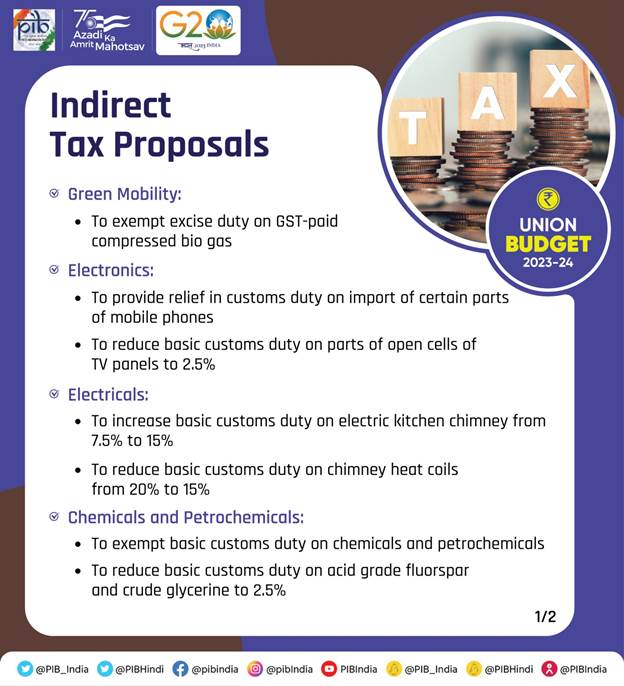 |
.png) |
Where does the Rupee Come from and where does it Go?

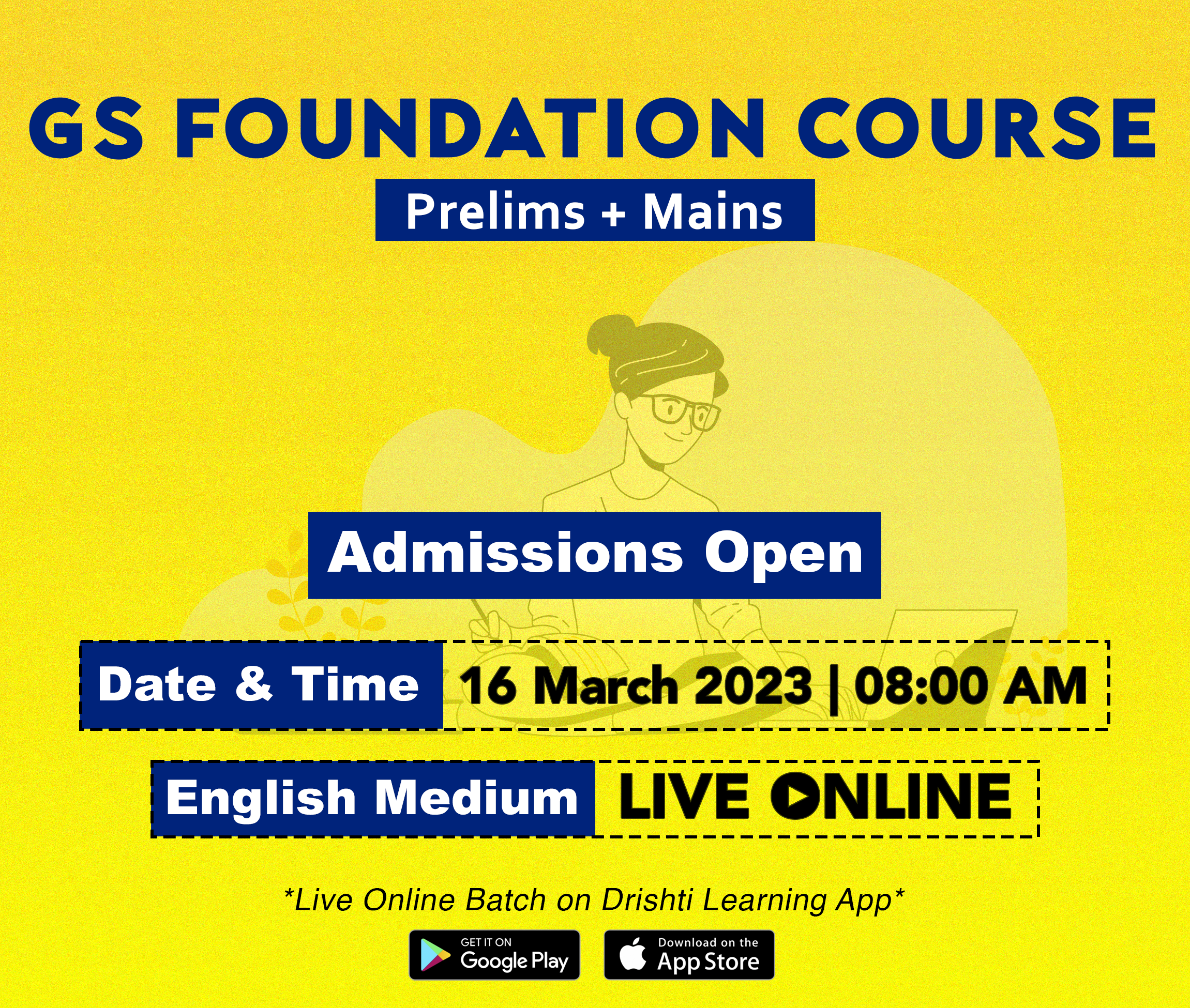
Indian Polity
Armed Forces and Adultery
Prelims: Adultery, Section 497 of the Indian Penal Code (IPC).
Mains: Armed Forces and Adultery.
Why in News?
Recently, the Supreme Court has ruled that armed forces can take action against their officers for adulterous acts, while stating the decriminalization of adultery does not apply to Armed Forces.
- In September 2018 Joseph Shine Judgment, the SC struck down Section 497 of the IPC that criminalised adultery, ruling that it was unconstitutional and violated women's right to equality in treating them as inferior to their husbands.
What is the Recent Ruling?
- The SC clarified that in the 2018 judgment, the SC was concerned only with the validity of Section 497 of the IPC and Section 198(2) of the CrPC dealing with adultery, and had “no occasion whatsoever to consider the effect” with respect to the Army, Navy and Air Force Acts.
- Defence personnel of the three wings — the Army, Navy and the Air Force were governed by special legislation, the Army Act, the Navy Act and the Air Force Act.
- These special laws impose restrictions on the fundamental rights of the personnel, who function in peculiar situation requiring utmost discipline.
- The three laws are protected by Article 33 of the Constitution, which allow the government to modify the fundamental rights of the armed forces personnel
- The Bench delivered the final Order in the case, clarifying that the Joseph Shine Judgment did not apply to members of the armed forces who are accused of ‘conduct unbecoming’ and dismissed the application.
What are the Significances?
- Abolishing adultery as a crime, might prevent members of the armed services from being found guilty of adulterous activities. When jawans and officers are deployed to hostile environments, other officers look after their families at base camp, and the laws and regulations that specify consequences for engaging in adulterous or promiscuous behavior aid in upholding discipline.
- Armed services soldiers who commit adultery with a coworker's wife may be cashiered from their jobs for acting unbecomingly.
What is Adultery?
- About:
- The act of adultery is a voluntary sexual intercourse between a married person and someone other than that person's current spouse or partner.
- Section 497 of the IPC:
- It mandates that whoever has sexual intercourse with the wife of another man, without the consent or connivance of that man, such sexual intercourse not amounting the offence of rape is guilty of the offence of adultery and shall be punished.
- The law does not punish his wife, since it presumes that only a man can seduce a woman into a sexual act, and that it is the husband who has suffered due to the sexual relationship of his wife, carried out without his consent. At the same time, the wife is not protected from similar behaviour committed by her husband.
- Adultery in the Indian Armed Forces:
- Regarding the Indian Armed Forces, military personnel are subject to the provisions of the IPC, including the law on adultery. In addition, the Indian military has its own set of regulations and codes of conduct that prohibit adultery and other forms of immoral behavior.
- The specific consequences for committing adultery in the Indian Armed Forces may vary, but can include administrative action, disciplinary action, or court-martial.
- The rules and procedures for dealing with such cases are established by the Indian military justice system.

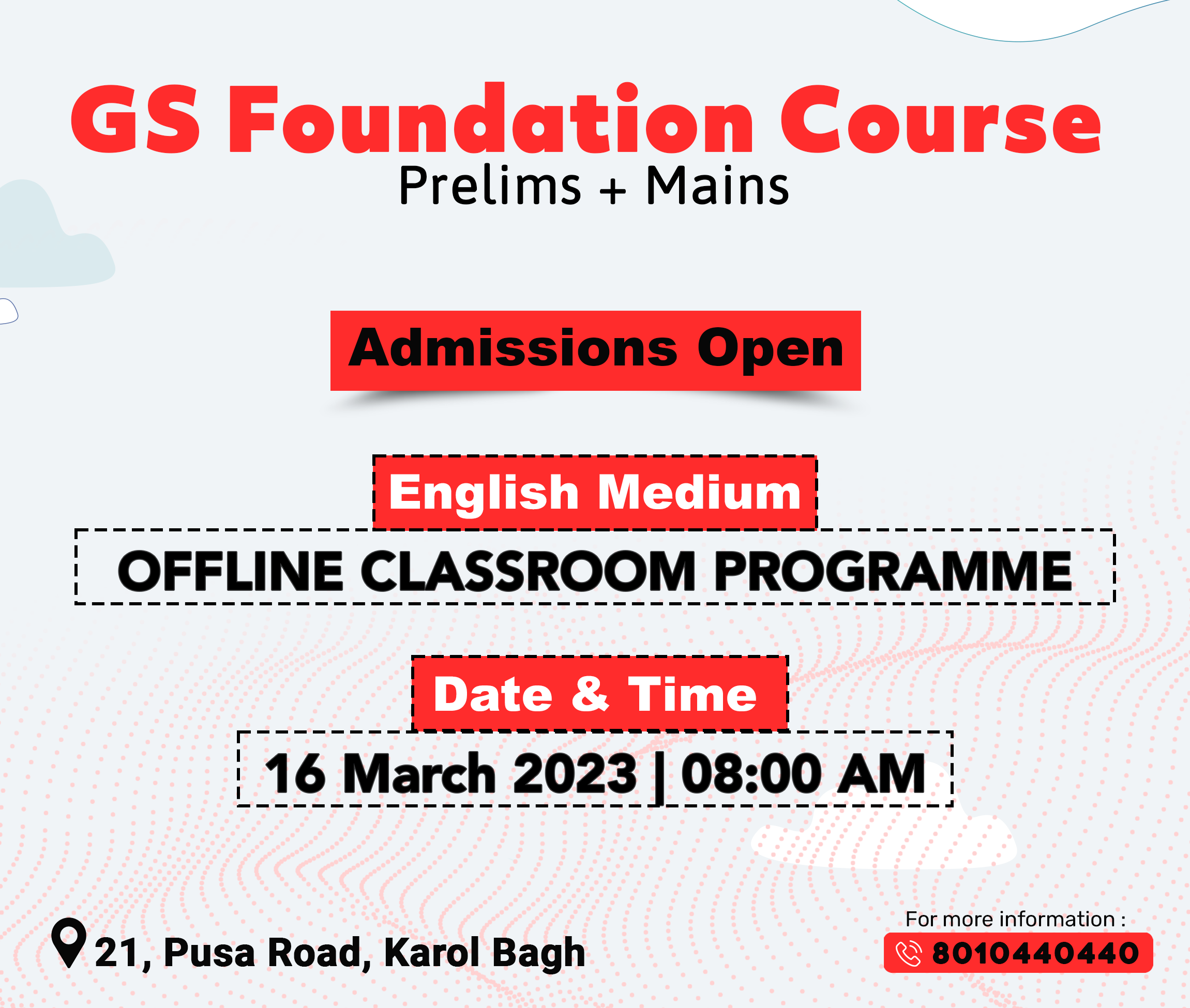
Economy
World Economic Outlook: IMF
Prelims: World Economic Outlook, IMF, Global Financial Stability Report, World Economic Outlook.
Mains: Important International Institutions, Effect of Policies & Politics of Countries on India's Interests.
Why in News?
Recently, the International Monetary Fund (IMF) has released its World Economic Outlook (WEO) Update, which has marginally improved the forecast for global growth in 2023.
What are the Key Takeaways of WEO?
- Global Growth will Bottom Out:
- The global growth, which was estimated at 3.4% in 2022, is now projected to fall to 2.9% in 2023 before rising to 3.1% in 2024.
- The IMF effectively rules out a global recession.
- Negative growth in global GDP (Gross Domestic Product) or global GDP per capita—which often happens when there is a global recession—is not expected.
- Instead, it expects global growth to bottom out in 2023 before starting to gather speed in 2024.
- Relief of Inflation will be Slower:
- Inflation-Disinflation:
- Inflation is expected to have peaked in 2022 but the disinflation will be slow and take all of 2023 and 2024.
- Headline Inflation:
- About 84% of countries are expected to have lower headline (consumer price index) inflation in 2023 than in 2022.
- Global Inflation:
- Global inflation is set to fall from 8.8 % in 2022 (annual average) to 6.6 % in 2023 and 4.3 % in 2024––above pre-pandemic (2017–19) levels of about 3.5 %.
- Slowing of Price Rise:
- Price rise is slowing for two main reasons:
- One, monetary tightening all across the world — higher interest rates drag down overall demand for goods and services and that, in turn, slows down inflation.
- Two, in the wake of a faltering demand, prices of different commodities — both fuel and non-fuel — have come down from their recent highs.
- In 2023, advanced economies are expected to have an inflation of 4.6% while emerging economies will continue to face an inflation of 8.1%.
- Price rise is slowing for two main reasons:
- Inflation-Disinflation:
- India will be the Fastest Growing Economy:
- India will be the world’s fastest growing economy in 2023 and 2024.
- Growth in India is set to decline from 6.8 % in 2022 to 6.1 % in 2023 before picking up to 6.8% in 2024, with resilient domestic demand despite external headwinds.
What is the International Monetary Fund?
- About:
- The IMF was set up along with the World Bank after the Second World War to assist in the reconstruction of war-ravaged countries.
- The two organizations agreed to be set up at a conference in Bretton Woods in the US. Hence, they are known as the Bretton Woods twins.
- Created in 1944, the IMF is governed by and accountable to the 190 countries that make up its near-global membership. India joined on 27th December 1945.
- The IMF came into formal existence in December 1945.
- The IMF's primary purpose is to ensure the stability of the international monetary system — the system of exchange rates and international payments that enables countries (and their citizens) to transact with each other.
- The Fund's mandate was updated in 2012 to include all macroeconomic and financial sector issues that bear on global stability.
- The IMF was set up along with the World Bank after the Second World War to assist in the reconstruction of war-ravaged countries.
- Reports by IMF:
- World Economic Outlook:
- It is a survey by the IMF that is usually published twice a year in the months of April and October.
- It analyzes and predicts global economic developments during the near and medium term.
- In response to the growing demand for more frequent forecast updates, the WEO Update is published in January and July, between the two main WEO publications released usually in April and October.
UPSC Civil Services Examination, Previous Year Question (PYQ)
Prelims
Q1. "Rapid Financing Instrument" and "Rapid Credit Facility" are related to the provisions of lending by which one of the following? (2022)
(a) Asian Development Bank
(b) International Monetary Fund
(c) United Nations Environment Programme Finance Initiative
(d) World Bank
Ans: (b)
Exp:
- Rapid Financing Instrument (RFI) provides quick financial assistance, which is available to all member countries facing urgent balance of payments requirements. The RFI was created as part of a broader reform to make IMF financial support more flexible to meet the diverse needs of member states. The RFI replaces the IMF's previous emergency assistance policy and can be used in a wide variety of circumstances.
- The Rapid Credit Facility (RCF) provides immediate balance of payments (BoP) requirements to low-income countries (LICs) with no ex-post condition, where a full economic program is neither necessary nor feasible. RCF was set up as part of a comprehensive reform to make the fund's financial support more flexible and better suited to suit the diverse needs of LIC including times of crisis.
- There are three areas under the RCF: (i) a "regular window" for immediate BoP needs due to a wide range of sources such as household instability, emergencies and fragility (ii) for immediate BoP needs due to sudden, exogenous shocks. an “exogenous shock window” and (iii) a “large natural disaster window” for immediate BoP needs due to natural disasters where the damage is estimated to be equal to or greater than 20% of the member's GDP.
Q2. “Gold Tranche” (Reserve Tranche) refers to (2020)
(a) a loan system of the World Bank
(b) one of the operations of a Central Bank
(c) a credit system granted by WTO to its members
(d) a credit system granted by IMF to its members
Ans: (d)
Q3. ‘Global Financial Stability Report’ is prepared by the (2016)
(a) European Central Bank
(b) International Monetary Fund
(c) International Bank for Reconstruction and Development
(d) Organization for Economic Cooperation and Development
Ans: (b)
Mains
Q. The World Bank and the IMF, collectively known as the Bretton Woods Institutions, are the two inter-governmental pillars supporting the structure of the world’s economic and financial order. Superficially, the World Bank and the IMF exhibit many common characteristics, yet their role, functions and mandate are distinctly different. Elucidate. (2013)

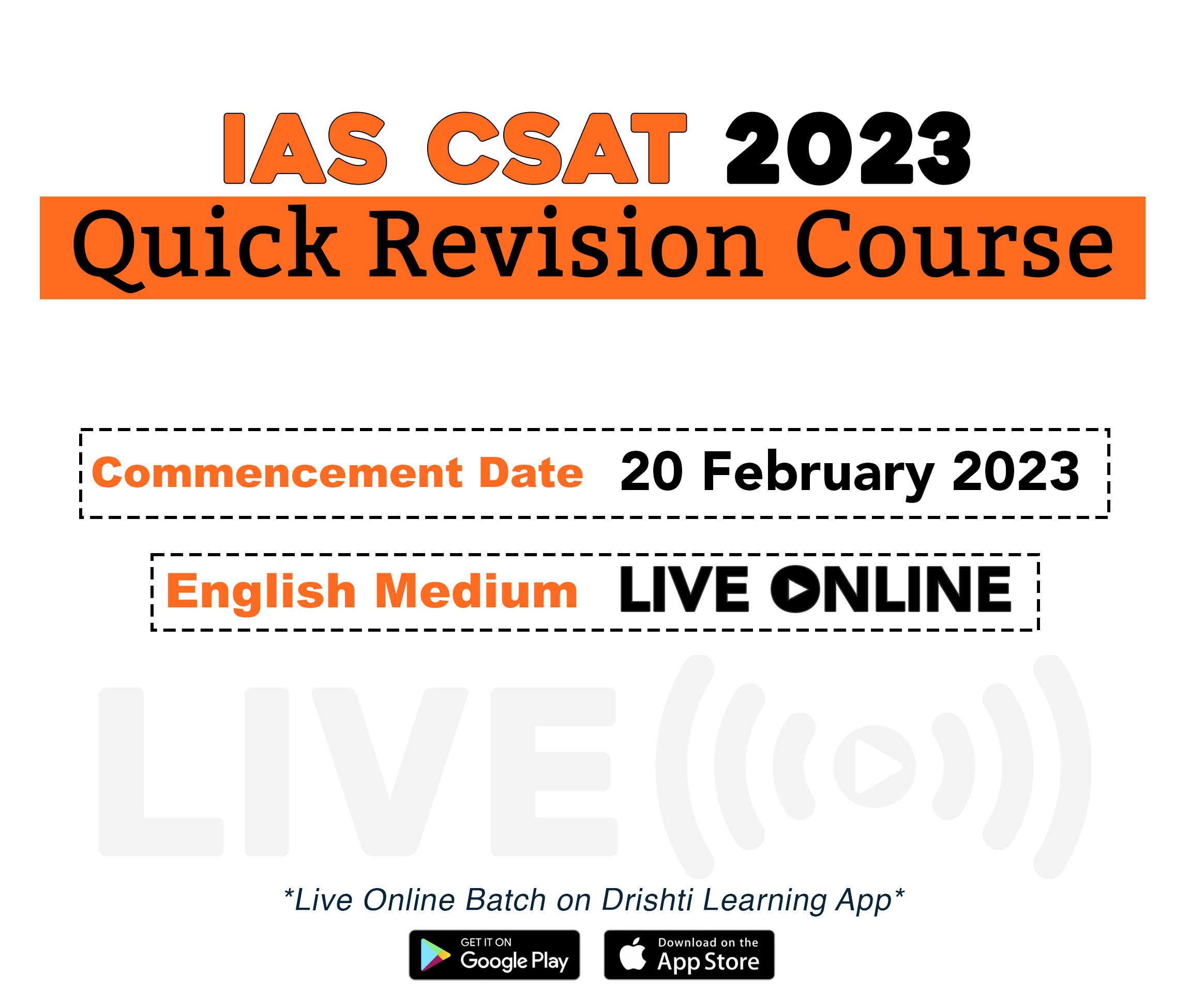
Biodiversity & Environment
World Likely to See 2°C Warming by 2050
Prelims: ANN, Climate Change, Global Warming, Paris Agreement.
Mains: Implications of Global warming.
Why in News?
Recently, a study published titled “contradicted projections from the Intergovernmental Panel on Climate Change (IPCC)”., states that the planet is likely to warm up by two degrees Celsius by 2050, even under a low-emission scenario.
- The researchers used artificial intelligence called Artificial Neural Networks (ANN) to predict the time for reaching the 1.5 °C and 2°C thresholds.
- The world has recorded a 1.1°C rise in temperature compared with the average in 1850-1900.
What are the Key Findings?
- Projection:
- There is a higher likelihood that 2°C will be reached under the low emission scenario compared with the IPCC AR6 (Sixth Assessment Report) synthesis assessment, and may fail to uphold the Paris Agreement.
- The Paris Agreement aims to limit the rise to below 2°C while pursuing efforts to limit the increase to 1.5°C.
- The IPCC estimated that the 1.5°C threshold could be attained as early as the 2030s under all emission scenarios.
- Global warming is already on the verge of crossing the 1.5°C threshold, even if the climate forcing pathway is substantially reduced in the near term.
- The threshold of 1.5°C will reach somewhere between 2033 and 2035 in the high, intermediate and low forcing scenarios.
- The world could touch 2°C by 2050 under the high-emission scenario, 2049 and 2054 in the intermediate and low-emission scenarios, respectively.
- In contrast, the IPCC estimated the likelihood of touching 2°C of global warming during the mid-21st century is high under a high-emission scenario.
- There is a higher likelihood that 2°C will be reached under the low emission scenario compared with the IPCC AR6 (Sixth Assessment Report) synthesis assessment, and may fail to uphold the Paris Agreement.
- Significance of Limiting Warming:
- Limiting warming to 1.5°C will reduce the number of people frequently exposed to extreme heat waves by about 420 million.
- It can also reduce the probability of drought and risks related to water availability.
- Implications:
- Warming above the threshold of 1.5°C can cause a broad range of climate risks — such as impacts on human health, economic growth, crop yields, coastal and small island communities, terrestrial and marine ecosystems, as well as the frequency, intensity and cost of extreme climate events.
What are Artificial Neural Networks?
- ANN is a vital subset of machine learning that helps computer scientists in their work on complex tasks, such as, strategizing, making predictions, and recognizing trends.
- It is a computational model that mimics the way nerve cells work in the human brain. It is designed to simulate the way the human brain analyzes and processes information.
UPSC Civil Services Examination, Previous Year Question (PYQ)
Prelims
Q. With reference to the Agreement at the UNFCCC Meeting in Paris in 2015, which of the following statements is/are correct? (2016)
- The Agreement was signed by all the member countries of the UN and it will go into effect in 2017.
- The Agreement aims to limit the greenhouse gas emissions so that the rise in average global temperature by the end of this century does not exceed 2ºC or even 1.5ºC above pre-industrial levels.
- Developed countries acknowledged their historical responsibility in global warming and committed to donate $ 1000 billion a year from 2020 to help developing countries to cope with climate change.
Select the correct answer using the code given below:
(a) 1 and 3 only
(b) 2 only
(c) 2 and 3 only
(d) 1, 2 and 3
Ans: (b)
Mains
Q1. Assess the impact of global warming on the coral life system with examples. (2017)
Q2. ‘Climate change’ is a global problem. How India will be affected by climate change? How Himalayan and coastal states of India will be affected by climate change? (2017)
Q3. Discuss global warming and mention its effects on the global climate. Explain the control measures to bring down the level of greenhouse gases which cause global warming, in the light of the Kyoto Protocol, 1997. (2022)

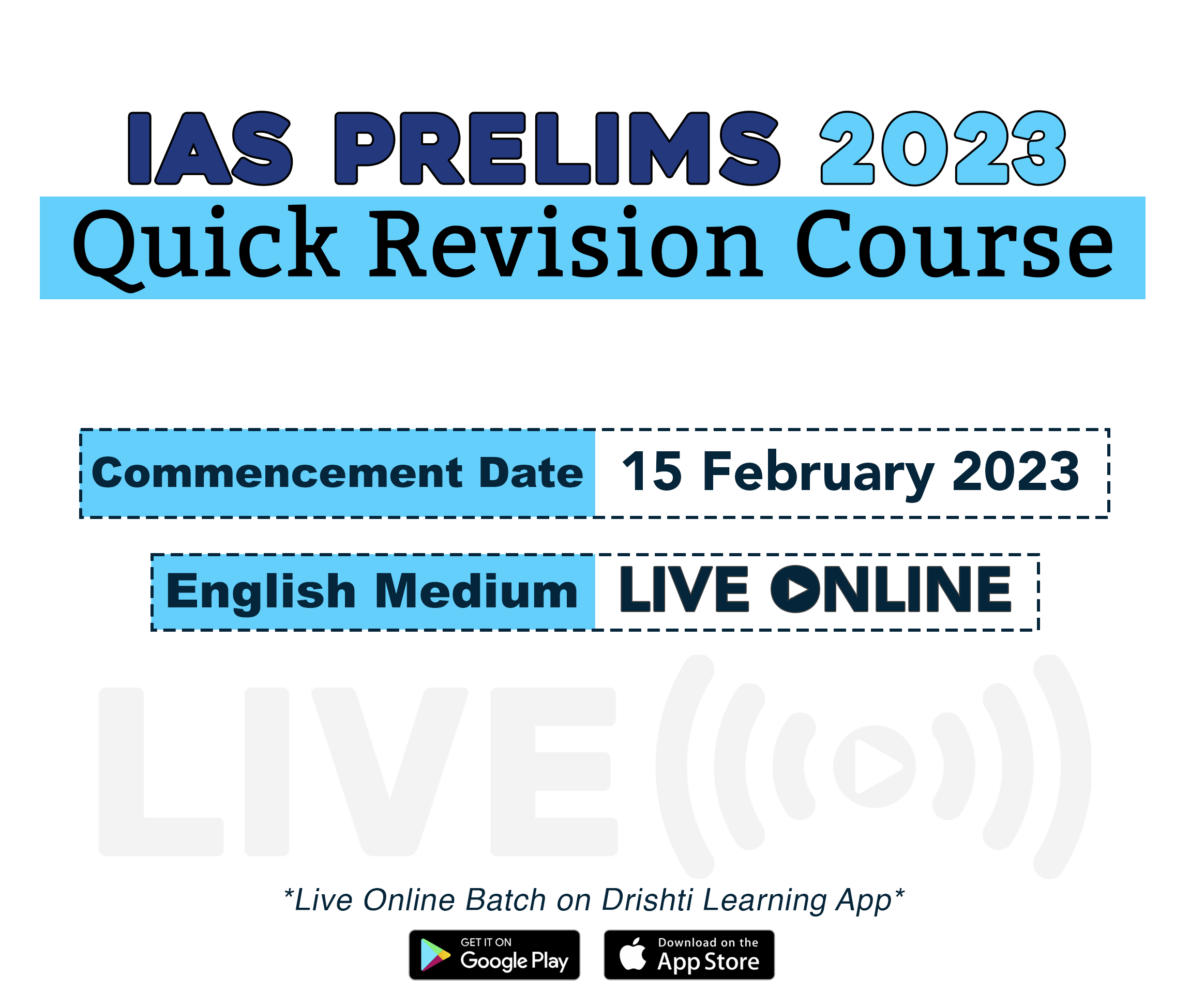
Rapid Fire
Rapid Fire Current Affairs
Khadi Fashion Show
Recently, a mega ‘Khadi fashion show’ was organised by the Khadi and Village Industries Commission (KVIC) in Rann of Kutch/ Kachchh. This mega event was the first such event of KVIC to establish new dimensions of the Khadi brand all over the world. The government of Gujarat holds a three-month long festival known as ‘The Rann Utsav’ every year.
The Rann of Kachchh is a salt marshy land in the Thar Desert in the kachchh district of western Gujarat. It lies between Gujarat in India and the Sindh province in Pakistan.
It is famous for its white salty desert sand and is reputed to be the largest salt desert in the world. The inhabitants of Kachchh are called Kachchhi and have a language of their own with the same name. Most of the population in Rann of Kachchh comprises of Hindus, Muslims, Jains and Sikhs.
Read More: Rann of Kutch/Kachchh, Thar Desert, Khadi and Village Industries Commission (KVIC)
WAN-IFRA
Recently, the Hindu Group has won four awards at the World Association of News Publishers (WAN-IFRA) Digital Media South Asia Awards 2022 for its various products and services. This was the sixth edition of the digital media awards for South Asia.
WAN-IFRA is the global organisation of the world’s press. Its mission is to protect the rights of journalists and publishers around the world to operate independent media. The goal is to provide members with expertise and services to innovate and prosper in a digital world and perform their crucial role in society.
Read More: Freedom of Media
IIMR in Hyderabad: Centre of Excellence (CoE)
Recently, during the presentation of the Union Budget 2023, Union Finance Minister announced that the Indian Institute of Millet Research (IIMR) in Hyderabad will act as a Centre of Excellence (CoE) for ‘Shree Anna’ to take the research on millets to the international level and make India a global hub for millets.
India is the world’s largest producer and second largest exporter of several types of ‘Shree Anna’ (millets) with a share of 41% in 2020, as per the Food and Agricultural Organisation (FAO). Rajasthan, Karnataka, Maharashtra and Andhra Pradesh are leading producers.
As the year 2023 has been declared the ‘International Year of Millet’ by the United Nations General Assembly (UNGA). The IIMR is considered the main driver behind the surge in the interest and consumption of millet-based products in the country in the last 5-6 years.
Read More: Centre of Excellence (CoE), Food and Agricultural Organisation (FAO), India's Millet Revolution, International Year of Millet
Myanmar Extends Emergency Rule
Recently, Myanmar's junta announced the extension of the country's state of emergency by another six months.
‘Coup’ is generally described as a sudden, violent, and illegal seizure of power from a government.
In the November 2020 parliamentary election, Suu Kyi’s party National League for Democracy (NLD) secured the majority of the seats.
In Myanmar's Parliament, the military holds 25% of the total seats according to the 2008 military-drafted constitution and several key ministerial positions are also reserved for military appointees. When the newly elected Myanmar lawmakers were to hold the first session of Parliament in 2021, the military imposed a state of emergency for one year citing massive voting fraud in the parliamentary elections.
Read More: Military Coup in Myanmar

